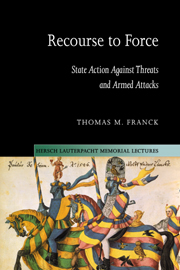Book contents
- Frontmatter
- Contents
- Acknowledgments
- 1 The United Nations' capacity for adapting to radical changes of circumstance
- 2 Use of force by the United Nations
- 3 The original parameters of self-defense
- 4 Self-defence against state-sponsored terrorists and infiltrators
- 5 Self-defense against ideological subversion
- 6 Self-defense against attacks on citizens abroad
- 7 Anticipatory self-defense
- 8 Countermeasures and self-help
- 9 The “purely humanitarian” intervention
- 10 What, eat the cabin boy? Uses of force that are illegal but justifiable
- Index
6 - Self-defense against attacks on citizens abroad
Published online by Cambridge University Press: 17 July 2009
- Frontmatter
- Contents
- Acknowledgments
- 1 The United Nations' capacity for adapting to radical changes of circumstance
- 2 Use of force by the United Nations
- 3 The original parameters of self-defense
- 4 Self-defence against state-sponsored terrorists and infiltrators
- 5 Self-defense against ideological subversion
- 6 Self-defense against attacks on citizens abroad
- 7 Anticipatory self-defense
- 8 Countermeasures and self-help
- 9 The “purely humanitarian” intervention
- 10 What, eat the cabin boy? Uses of force that are illegal but justifiable
- Index
Summary
This chapter examines instances in which an expansive concept of “self-defence” has been advanced by a state to justify using force to protect citizens abroad, either by military rescue or by forcibly deterring those who threaten their safety.
Powerful states have long claimed a legal right to use military force (“gun-boat diplomacy”) to this end. In the nineteenth-century case of Durand v. Hollins, the US Circuit Court of Appeals said:
Under our system of government, the citizen abroad is as much entitled to protection as the citizen at home. The great object and duty of government is the protection of the lives, liberty and property of the people composing it, whether abroad or at home; and any government failing in the accomplishment of the object, or the performance of the duty, is not worth preserving.
At issue in Durand was the President's constitutional authority, without obtaining a Congressional declaration of war, to order a naval bombardment of San Juan del Norte (Greytown), Nicaragua, as reprisal against those of its inhabitants who “had perpetrated acts of violence against the US nationals and their property.” Although in upholding this exercise of plenary power, the Court was declaring US, not international, law, it acted in recognition of what it claimed was the widespread state practice of “humanitarian intervention” and “citizen rescue.”
These practices, whatever their currency at that earlier time, have now become problematic.
- Type
- Chapter
- Information
- Recourse to ForceState Action against Threats and Armed Attacks, pp. 76 - 96Publisher: Cambridge University PressPrint publication year: 2002

